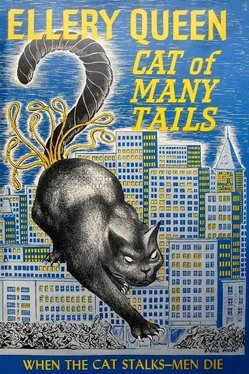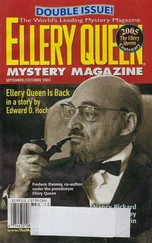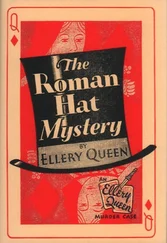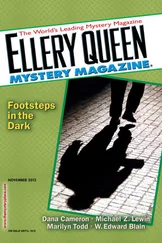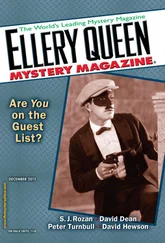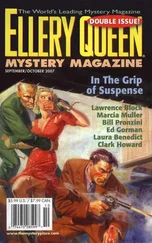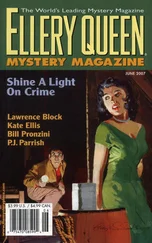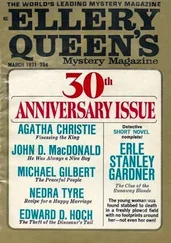“I’m sorry!” She was really trying to stop. “I’m so sorry. Edward, let me go. Please. I want to... get something.”
“Tell you what, darling. Give me twenty-four hours’ sleep, a two-inch T-bone when I wake up, and I’ll tackle it where I left off. Good enough?”
She kissed him suddenly. Then, murmuring something, she hurried out.
“I submit, gentlemen,” said the Mayor, “that we owe Mrs. Cazalis a few dozen roses.”
“My only weakness,” laughed the psychiatrist. “I never could resist the diffusion of the female lachrymal glands.”
“Then, Doctor,” said Ellery, “you may be in for a bad time.”
“How’s that, Mr. Queen?”
“If you’ll run over the ages of the seven victims, you’ll find that each victim had been younger than the one preceding.”
The Commissioner’s cigar almost fell out of his mouth.
The Mayor went brick-red.
“The seventh victim, Doctor — your wife’s niece-was 25 years old. If any prediction is possible in this case, it’s that Victim Number 8 will be under 25. Unless you’re successful, or we are, we may soon be investigating the strangulation of children.” Ellery set his glass down. “Would you say good night to Mrs. Cazalis for me?”
The so-called “Cat Riots” of September 22–23 marked the dread appearance in New York City of mobile vulgus for the first time since the Harlem disorders of almost fifteen years before. But in this case the mob was predominantly white; as a wry vindication of the Mayor’s dawn press conference of the previous month, there was no “race angle.” The only racial fears involved were the primitive ones of all mankind.
Students of mob psychology found the Cat Riots interesting. If in one sense the woman whose hysterical outburst set off the panic in Metropol Hall exerted the function of the inevitable meneur — the leader each mob tends to throw up, who starts the cheering or the running away — if the hysterical woman represented the fuse which sparked the explosion, she in her turn had been ignited by the inflammatory Citizens’ Action Teams which had sprung up all over the Greater City during the immediately preceding Four Days and whose activities were responsible for her presence in the Hall. And no one could say with certainty who originally inspired those groups; at least no individual responsibility was ever determined.
The shortlived movement which came to be known as the Four Days (although from inception to culminating riot it spanned six days) was first publicly taken note of early on Monday, September 19, in the late morning editions of the newspapers.
An “association of neighbors” had been formed over the past weekend on the Lower East Side under the name of “The Division Street Vigilantes.” At an organizing meeting held Saturday night a series of resolutions had been drawn up in the form of a “Declaration” which was ratified “in full convention assembled” on the following afternoon. Its “Preamble” asserted “the rights of lawabiding American citizens, in the failure of regular law enforcement,” to band together “for common security.” Anyone in the prescribed neighborhood was eligible to join. World War II veterans were especially solicited. Various patrols were to be set up: a Streets Patrol, a Roofs Patrol, an Alleys Patrol. There was a separate Unit Patrol for each dwelling or other building in the area. The function of the patrols was “to stand guard against the marauder who has been terrorizing the City of New York.” (There was some intra-organizational protest against the use of “fancy language,” but the language stood when the Resolutions Committee pointed out that “on Division Street and around here we’re supposed to be a bunch of pigs.”) Discipline was to be military. Patrolmen were to be equipped with flashlights, armbands, “and available weapons of defense.” A 9 P.M. curfew for children was to be enforced. Street level lighting was to be maintained until daybreak; special arrangements were being made with landlords of dwellings and stores.
In the same news story was noted the simultaneous formation of three similar organizations, apparently unconnected with one another or with the Division Street Vigilantes. One was in the Murray Hill section and called itself “The Murray Hill Committee of Safety.” Another took in the area between West 72nd Street and West 79th Street and was named “The West End Minutemen.” The third centered in Washington Square, “The Village Home Guard.”
Considering the differences among the three groups culturally, socially, and economically, their avowed purposes and operating methods were astonishingly similar to those of the Division Street Vigilantes.
Editorials that morning commented on “the coincidence of four widely separated communities setting the same idea over the same weekend” and wondered “if it is so much of a coincidence as it appears.” The anti-Administration papers blamed the Mayor and the Police Commissioner and used phrases like “the traditional American way” and “the right to defend the American home.” The more responsible journals deplored the movement and one of them was “confident that the traditional good humor of New York will laugh these well-meaning but overexcited people back to their senses.” Max Stone, editorial writer of the leading liberal paper, wrote: “This is fascism on the sidewalks of New York.”
By 6 P.M. Monday the newscasters were reporting to their audiences that “at least three dozen action committees have sprung up in scattered neighborhoods of the five boroughs since the announcement this morning of the organization of the Division Street, Murray Hill, West End Avenue, and Greenwich Village groups.”
The late evening editions of the newspapers were able to say that “the idea is spreading like an old-fashioned prairie fire. By press time the number of action committees was over a hundred.”
By Tuesday morning the count was reported as “hundreds.”
The term “Citizens’ Action Teams” seems to have first appeared in a Tuesday Extra story on the amazing citywide phenomenon. The story was bylined “Jimmy Leggitt.” The phrase took hold when Winchell, Lyons, Wilson, and Sullivan noted in their columns that its initials spelled “cat.” And CATs they remained.
At an emergency meeting in the Mayor’s office Monday night, the Police Commissioner expressed himself as being in favor of “taking tough police measures to stop this thing dead in its tracks. We can’t have every Joe, Moe, and Schmo in town a selfappointed cop. It’s anarchy, Jack!” But the Mayor shook his head. “You’re not going to put out a fire by passing a law against it, Barney. We can’t stop this movement by force; it’s out of the question. What we’ve got to do is try to control it.”
At his press conference Tuesday morning the Mayor said with a smile, “I repeat that this Cat thing has been exaggerated far out of proportion and there is absolutely no basis for public alarm with the Police Department working on it twenty-four hours a day. These groups will function much more in the public interest with the advice and assistance of the authorities. The Police Commissioner and his various heads of department will be on hand all day today to receive delegations of these groups with the end in view of systematizing and co-ordinating their activities, in much the way that the splendid ARP groups operated during the War.”
Disturbingly, the groups did not appear to be received.
On Tuesday night the Mayor went on the air. He did not in the slightest impugn the integrity and good intentions of the people forming home defense groups, but he felt sure all reasonable people would agree that the police power of the greatest city in the world could not be permitted to be usurped by individual citizens, no matter how honest or well-intentioned, in defiance of legal authority. “Let it not be said that the City of New York in the fifth decade of the twentieth century resorted to frontier town vigilante law.” The dangers implicit in this sort of thing were recognized by all, he was certain, as far exceeding any possible threat of one homicidally inclined psychotic. “In the old days, before the establishment of official police systems, night patrols of citizens were undoubtedly necessary to protect communities from the robberies and murders of the criminal element; but in the face of the record of New York’s Finest, what justifications is there for such patrols today?” He would regret, the Mayor stated, having to resort to countermeasures in the allover public interest. He knew such a step would prove unnecessary. “I urge all already functioning groups of this nature, and groups in the process of organizing, to get in touch immediately with their police precincts for instructions.”
Читать дальше
